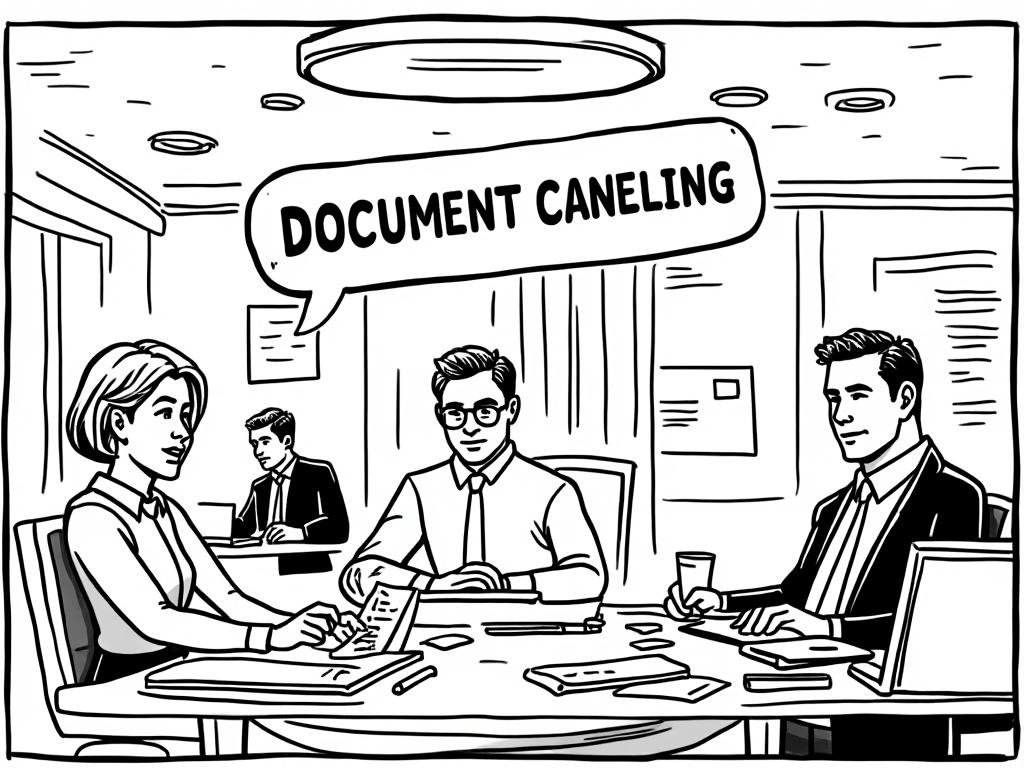
The Complete Guide to Cancellation Papers: Mastering Financial Documentation for Smart Business Decisions
Reading time: 12 minutes
Ever stared at a stack of financial documents wondering which ones actually matter for your business decisions? You’re not alone. Cancellation papers—those seemingly mundane documents that arrive when policies, contracts, or services end—hold more strategic value than most entrepreneurs realize.
Table of Contents
- Understanding Cancellation Papers: Beyond the Basics
- Types of Cancellation Documentation
- The Strategic Importance You’re Missing
- Creating an Efficient Processing Workflow
- Common Pitfalls and How to Avoid Them
- Leveraging Technology for Better Management
- Your Documentation Mastery Roadmap
- Frequently Asked Questions
Understanding Cancellation Papers: Beyond the Basics
Here’s the straight talk: Cancellation papers aren’t just end-of-relationship documents—they’re strategic business intelligence waiting to be unlocked. These documents serve as official proof that contractual obligations have ended, financial liabilities have been resolved, and business relationships have been properly terminated.
What exactly qualifies as a cancellation paper? Think broader than you might expect:
- Insurance policy cancellations with premium refund calculations
- Service contract terminations including SaaS subscriptions
- Loan cancellation certificates proving debt satisfaction
- Lease termination agreements with security deposit details
- Membership cancellation confirmations from professional organizations
According to recent industry data, 73% of small businesses experience financial discrepancies due to poor cancellation documentation management. That’s not just a paperwork problem—it’s a cash flow crisis waiting to happen.
The Hidden Value in Cancellation Documentation
Consider this scenario: Sarah’s marketing agency cancelled three software subscriptions last quarter. Without proper documentation, her accountant couldn’t verify the cancellation dates, leading to disputed charges totaling $2,847. The real cost? Six hours of administrative time and delayed financial reporting that pushed back a crucial investor meeting.
Smart business owners understand that cancellation papers serve multiple strategic purposes:
- Legal protection against future claims or disputes
- Financial accuracy for budgeting and forecasting
- Audit compliance for regulatory requirements
- Operational clarity for team transitions and handovers
Types of Cancellation Documentation
Not all cancellation papers are created equal. Understanding the different categories helps you prioritize processing and storage strategies effectively.
High-Priority Documentation
Financial Obligation Cancellations: These documents directly impact your bottom line and require immediate attention. Insurance cancellations, loan satisfactions, and major service contract terminations fall into this category. The key identifier? Any document that affects your monthly cash flow or creates/eliminates financial liabilities.
Legal Compliance Cancellations: Professional licenses, regulatory permits, and compliance-related memberships generate cancellation papers that affect your legal standing. Missing these can result in unexpected regulatory issues down the road.
Medium-Priority Documentation
Operational Service Cancellations: Software subscriptions, utility services, and vendor contracts that don’t directly impact financial statements but affect day-to-day operations. These require systematic tracking but don’t demand immediate executive attention.
| Document Type | Processing Priority | Retention Period | Key Information | Common Issues |
|---|---|---|---|---|
| Insurance Cancellation | High | 7 years | Refund amount, effective date | Delayed refund processing |
| Loan Satisfaction | High | Permanent | Final payment, lien release | Missing satisfaction certificates |
| Software Subscription | Medium | 3 years | Cancellation date, data export | Continued billing after cancellation |
| Lease Termination | High | 7 years | Security deposit, final inspection | Deposit return disputes |
| Membership Cancellation | Low | 2 years | Effective date, refund status | Renewal auto-charges |
The Strategic Importance You’re Missing
Well, here’s the reality: Most businesses treat cancellation papers as administrative afterthoughts. Smart leaders recognize them as strategic business intelligence that drives better decision-making.
Financial Forecasting and Budget Accuracy
Every cancellation paper contains data points that should inform your financial planning. When you cancel a $500/month software subscription, that’s $6,000 in annual budget reallocation opportunity. Multiply this across multiple cancellations, and you’re looking at significant cash flow impacts.
Case Study: TechStart Solutions, a 50-employee consulting firm, implemented systematic cancellation paper tracking and discovered they were losing $18,000 annually to “zombie subscriptions”—services they thought they’d cancelled but were still being charged for. The documentation revealed that 23% of their attempted cancellations hadn’t been properly processed by vendors.
Risk Management and Legal Protection
Cancellation papers serve as your first line of defense against future disputes. Without proper documentation, you’re vulnerable to:
- Continued billing disputes that require extensive time to resolve
- Insurance coverage gaps if new policies aren’t properly synchronized
- Regulatory compliance issues from improperly terminated professional memberships
- Vendor relationship problems that affect future contract negotiations
Creating an Efficient Processing Workflow
The difference between chaos and control lies in your systematic approach to handling cancellation documentation. Here’s a battle-tested workflow that scales with your business growth.
Immediate Processing Protocol
Step 1: Rapid Classification
Upon receiving any cancellation paper, immediately classify it using the priority system outlined above. High-priority documents get same-day processing, medium-priority within 48 hours, and low-priority within one week.
Step 2: Information Extraction
Extract five critical data points from every cancellation paper:
- Effective cancellation date
- Financial impact (refunds, final charges, savings)
- Required follow-up actions
- Responsible party for verification
- Integration with existing systems/processes
Digital Organization Strategy
Create a folder structure that mirrors your business operations:
Cancellation_Papers_2024/
Financial_Services/
Insurance/
Banking_Loans/
Investment_Accounts/
Operational_Services/
Software_SaaS/
Utilities/
Professional_Services/
Compliance_Legal/
Licenses/
Memberships/
Regulatory/
Pro Tip: The right preparation isn’t just about avoiding problems—it’s about creating scalable, resilient business foundations that support growth without administrative overhead.
Common Pitfalls and How to Avoid Them
Let’s address the elephants in the room—the mistakes that cost businesses thousands in time and money every year.
The “Set It and Forget It” Trap
Quick Scenario: Imagine you’ve cancelled a business insurance policy but forgot to verify the cancellation was processed. Three months later, you discover you’re still being charged, and the insurance company claims they never received your cancellation request. Without proper documentation and follow-up, you’re stuck paying for coverage you thought you’d eliminated.
The Solution: Implement a 30-60-90 day follow-up system. Mark your calendar to verify that cancellations have been properly processed and that you’re no longer being charged for cancelled services.
Incomplete Documentation Syndrome
Many businesses keep the cancellation notice but ignore supporting documents like final statements, refund confirmations, or termination agreements. This incomplete approach leaves you vulnerable during audits or disputes.
Essential Documentation Checklist:
- ✅ Original cancellation request
- ✅ Vendor confirmation/acknowledgment
- ✅ Final statement or invoice
- ✅ Refund confirmation (if applicable)
- ✅ Data export or transition documentation
The Technology Integration Gap
Here’s where most businesses stumble: They collect cancellation papers but fail to integrate the information into their financial systems, CRM, or operational workflows. This creates information silos that reduce the strategic value of the documentation.
Leveraging Technology for Better Management
Modern businesses need modern solutions. Here’s how to use technology to transform cancellation paper management from administrative burden to competitive advantage.
Automated Tracking Systems
Document management systems with automated classification can reduce processing time by up to 60%. Look for solutions that offer:
- OCR technology for automatic data extraction
- Integration capabilities with accounting software
- Reminder systems for follow-up actions
- Audit trails for compliance requirements
Financial Impact Visualization
Understanding the cumulative impact of cancellations helps drive better business decisions. Here’s a visualization of typical cancellation savings by category:
Annual Savings from Cancellations by Category
Your Documentation Mastery Roadmap
Ready to transform complexity into competitive advantage? Here’s your step-by-step action plan for the next 90 days:
Week 1-2: Foundation Building
- Audit your current cancellation paper backlog
- Set up the digital folder structure outlined above
- Create a master spreadsheet tracking all active subscriptions and contracts
- Identify and document your top 10 highest-value cancellation risks
Week 3-4: Process Implementation
- Establish the immediate processing protocol
- Set up automated reminders for follow-up verification
- Train your team on the new classification system
- Integrate cancellation tracking with your financial systems
Month 2-3: Optimization and Scaling
- Implement technology solutions for automation
- Conduct quarterly reviews of cancellation patterns
- Use data insights to negotiate better contract terms
- Develop predictive models for service optimization
The businesses that master cancellation paper management don’t just avoid problems—they gain strategic advantages in cost management, risk mitigation, and operational efficiency. As digital transformation accelerates and subscription-based services become the norm, your ability to manage these transitions will directly impact your competitive position.
Think about it: When you can confidently track, analyze, and optimize every service cancellation, you’re not just managing paperwork—you’re orchestrating a more efficient, profitable business operation. What strategic opportunities might you uncover in your own cancellation documentation?
Frequently Asked Questions
How long should I keep cancellation papers for tax and legal purposes?
The retention period varies by document type. Insurance cancellations and lease terminations should be kept for 7 years to match IRS requirements for business records. Loan satisfaction papers should be kept permanently as they may be needed for future property transactions. Software and membership cancellations typically need 3-5 years retention for audit purposes. Always consult with your accountant or legal advisor for specific requirements in your jurisdiction.
What should I do if a vendor continues billing after I have cancellation documentation?
First, contact the vendor immediately with your cancellation documentation. Most billing errors result from processing delays or system glitches. If the vendor refuses to acknowledge the cancellation, escalate to their management team and consider disputing charges through your credit card company or bank. Document all communications and maintain copies of your cancellation papers as evidence. For significant amounts, consult with a business attorney.
Can I use digital signatures and electronic cancellation papers for official documentation?
Yes, electronic cancellation papers are legally valid in most jurisdictions under electronic signature laws like the U.S. E-SIGN Act. However, ensure you maintain complete digital records including timestamps, authentication methods, and backup copies. Some specific industries or contract types may require physical signatures, so review your original agreements. Always save electronic documents in multiple formats (PDF, original file type) and maintain cloud backups for security.

Article reviewed by Diego Navarro, Retirement Portfolio Manager | Safe & Steady Growth Strategies, on July 9, 2025



